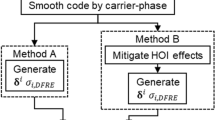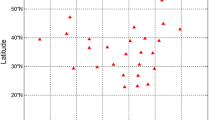Abstract
The dual-frequency multi-constellation (DFMC) satellite-based augmentation system (SBAS) should be able to provide a vertical protection level in the range of 10–12 m, which is sufficient to support Category I precision approach operations. Because of the limited data rate of the SBAS signal and the need to augment 91 satellites simultaneously, DFMC SBAS does not broadcast equivalent terms for fast pseudorange corrections in legacy L1-only SBAS. An analysis of the wide area augmentation system (WAAS) suggests that the range error after applying long-term satellite error corrections, known as satellite clock–ephemeris (SCE) corrections in DFMC SBAS, is not accurate enough for Category I operations. Thus, it is necessary to improve the accuracy of these SCE corrections. With the construction of DFMC SBAS, there is an opportunity to upgrade the SCE correction algorithm. Based on the fact that the Global Navigation Satellite System SCE parameter-fitting error constitutes the majority of the SCE error, we propose a method of computing the SCE corrections by combining a priori knowledge of the SCE parameter-fitting error with real-time measurements. A comparison of the user range error after applying WAAS SCE corrections and fast corrections indicates that the proposed method extends the period when a satellite is augmented by 22.9 % and reduces the root mean square error by 27 %.





Similar content being viewed by others
References
Anonymous (2015a) Global positioning system (GPS) standard positioning service (SPS) performance analysis report #90. William J. Hughes Technical Center. http://www.nstb.tc.faa.gov/REPORTS/PAN90_0715.pdf
Anonymous (2015b) Wide-area augmentation system performance analysis report #53. William J. Hughes Technical Center. http://www.nstb.tc.faa.gov/reports/waaspan53.pdf
Arnold LL, Zandbergen PA (2011) Positional accuracy of the wide area augmentation system in consumer-grade GPS units. Comput Geosci 37(7):883–892. doi:10.1016/j.cageo.2010.12.011
Arnold D, Meindl M, Beutler G, Dach R, Schaer S, Lutz S, Jäggi A (2015) CODE’s new solar radiation pressure model for GNSS orbit determination. J Geodesy 89(8):775–791. doi:10.1007/s00190-015-0814-4
Böhm J, Niell A, Tregoning P, Schuh H (2006) Global mapping function (GMF): a new empirical mapping function based on numerical weather model data. Geophys Res Lett. doi:10.1029/2005GL025546
Böhm J, Heinkelmann R, Schuh H (2007) Short note: a global model of pressure and temperature for geodetic applications. J Geodesy 81(10):679–683
Dach R, Hugentobler U, Fridez P, Meindl M (2007) User manual of the Bernese GPS software version 5.0. Astronomical Institute, University of Bern
Dautermann T (2014) Civil air navigation using GNSS enhanced by wide area satellite based augmentation systems. Prog Aerosp Sci 67(3):51–62. doi:10.1016/j.paerosci.2014.01.003
Enge P, Walter T, Pullen S, Kee C, Chao YC, Tsai YJ (1996) Wide area augmentation of the global positioning system. Proc IEEE 84(8):1063–1088. doi:10.1109/5.533954
Fidalgo J, Odriozola M, Cueto M, Cezón A, Caro J, Rodriguez C, Brocard D, Denis JC, Chatre E (2014) SBAS L5 enhanced ICD for aviation: definition and preliminary experimentation results. In: Proceedings on ION GNSS + 2014, Institute of Navigation, Tampa, Florida, pp 3289–3298, 8–12 Sept
Gelb A (1974) Applied optimal estimation. MIT press, Cambridge
Grewal MS (2012) Space-based augmentation for global navigation satellite systems. IEEE Trans Ultrason Ferroelectr Freq Control 59(3):497–503. doi:10.1109/TUFFC.2012.2220
Hackel S, Steigenberger P, Hugentobler U, Uhlemann M, Montenbruck O (2013) Galileo orbit determination using combined GNSS and SLR observations. GPS Solut 19(1):15–25. doi:10.1007/s10291-013-0361-5
Heßelbarth A, Wanninger L (2013) SBAS orbit and satellite clock corrections for precise point positioning. GPS Solut 17(4):465–473. doi:10.1007/s10291-012-0292-6
Kim J, Lee YJ (2015) Using ionospheric corrections from the space-based augmentation systems for low earth orbiting satellites. GPS Solut 19(3):423–431. doi:10.1007/s10291-014-0402-8
Li XR, Jilkov VP (2003) Survey of maneuvering target tracking. Part I. Dynamic models. IEEE Trans Aerosp Electron Syst 39(4):1333–1364. doi:10.1109/TAES.2003.1261132
Rodriguez-Solano CJ, Hugentobler U, Steigenberger P (2012) Adjustable box-wing model for solar radiation pressure impacting GPS satellites. Adv Space Res 49(7):1113–1128. doi:10.1016/j.asr.2012.01.016
Roturier B, Chatre E, Ventura-Traveset J (2001) The SBAS integrity concept standardised by ICAO. Application to EGNOS. EGNOS resources. http://www.egnos-pro.esa.int/Publications/GNSS%202001/SBAS_integrity.pdf. Accessed 10 July 2016
RTCA (2006) Minimum operational performance standards for global positioning system/wide area augmentation system airborne equipment, RTCA DO-229D. RTCA, Inc., December 2006
Shallberg K, Sheng F (2008) WAAS measurement processing; current design and potential improvements. In: Proceedings on ION PLANS 2008, Institute of Navigation, Monterey, CA, pp 253–262, 5–8 May 2008. doi:10.1109/PLANS.2008.4570014
Shallberg K, Shloss P, Altshuler E, Tahmazyan L (2001) WAAS measurement processing, reducing the effects of multipath. In: Proceedings on ION GPS 2001, Institute of Navigation, Salt Lake City, UT, pp 2334–2340, 11–14 Sept
Singer R (1970) Estimating optimal tracking filter performance for manned maneuvering targets. IEEE Trans Aerosp Electron Syst 6(4):473–483. doi:10.1109/TAES.1970.310128
Sparks L, Blanch J, Pandya N (2011a) Estimating ionospheric delay using kriging: 1. Methodology. Radio Sci 46(6):999–1010. doi:10.1029/2011RS004667
Sparks L, Blanch J, Pandya N (2011b) Estimating ionospheric delay using kriging: 2. Impact on satellite-based augmentation system availability. Radio Sci 46(6):1241–1249. doi:10.1029/2011RS004667
Springer TA, Hugentobler U (2001) IGS ultra rapid products for (near-) real-time applications. Phys Chem Earth Part A Solid Earth Geodesy 26(6):623–628. doi:10.1016/S1464-1895(01)00111-9
Wang S, Zhu B (2013) A new method to make ionospheric delay corrections in SBAS for GPS and Compass dual constellations. In: Proceedings on ION GNSS + 2013, Institute of Navigation, Nashville, Tennessee, pp 865–874, 16–20 Sept
Acknowledgments
The authors gratefully acknowledge Beijing Laboratory for General Aviation Technology and Beijing Key Laboratory (No. BZ0272) for generous financial support.
Author information
Authors and Affiliations
Corresponding author
Rights and permissions
About this article
Cite this article
Chen, J., Huang, Z. & Li, R. Computation of satellite clock–ephemeris corrections using a priori knowledge for satellite-based augmentation system. GPS Solut 21, 663–673 (2017). https://doi.org/10.1007/s10291-016-0555-8
Received:
Accepted:
Published:
Issue Date:
DOI: https://doi.org/10.1007/s10291-016-0555-8




